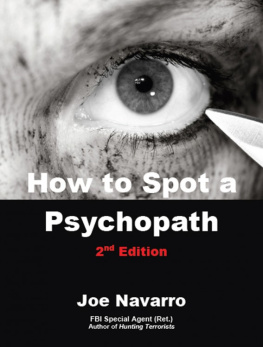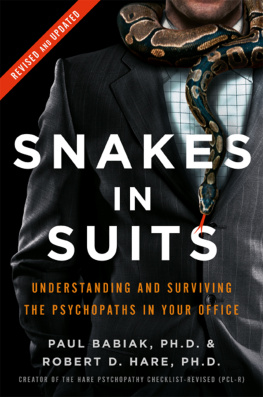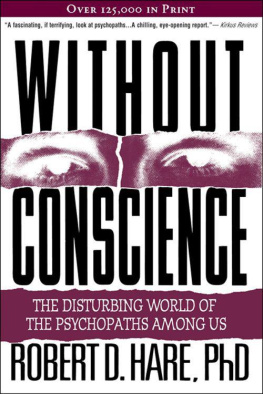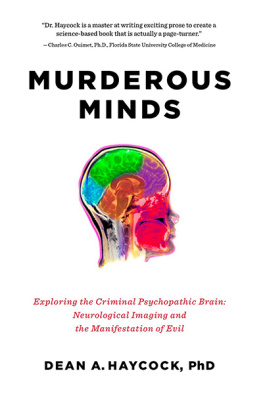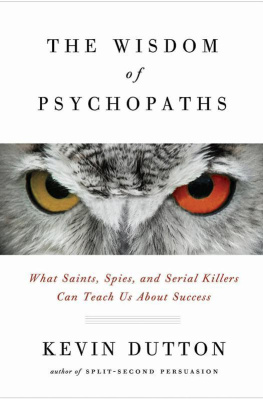Kent A. Kiehl PhD - The Psychopath Whisperer: The Science of Those Without Conscience
Here you can read online Kent A. Kiehl PhD - The Psychopath Whisperer: The Science of Those Without Conscience full text of the book (entire story) in english for free. Download pdf and epub, get meaning, cover and reviews about this ebook. year: 2014, publisher: Crown, genre: Detective and thriller. Description of the work, (preface) as well as reviews are available. Best literature library LitArk.com created for fans of good reading and offers a wide selection of genres:
Romance novel
Science fiction
Adventure
Detective
Science
History
Home and family
Prose
Art
Politics
Computer
Non-fiction
Religion
Business
Children
Humor
Choose a favorite category and find really read worthwhile books. Enjoy immersion in the world of imagination, feel the emotions of the characters or learn something new for yourself, make an fascinating discovery.

- Book:The Psychopath Whisperer: The Science of Those Without Conscience
- Author:
- Publisher:Crown
- Genre:
- Year:2014
- Rating:3 / 5
- Favourites:Add to favourites
- Your mark:
The Psychopath Whisperer: The Science of Those Without Conscience: summary, description and annotation
We offer to read an annotation, description, summary or preface (depends on what the author of the book "The Psychopath Whisperer: The Science of Those Without Conscience" wrote himself). If you haven't found the necessary information about the book — write in the comments, we will try to find it.
We know of psychopaths from chilling headlines and stories in the news and moviesfrom Ted Bundy and John Wayne Gacy, to Hannibal Lecter and Dexter Morgan. As Dr. Kent Kiehl shows, psychopaths can be identified by a checklist of symptoms that includes pathological lying; lack of empathy, guilt, and remorse; grandiose sense of self-worth; manipulation; and failure to accept ones actions. But why do psychopaths behave the way they do? Is it the result of their environment how they were raisedor is there a genetic component to their lack of conscience?
This is the question Kiehl, a protg of famed psychopath researcher Dr. Robert Hare, was determined to answer as he began his career twenty years ago. To aid in his quest to unravel the psychopathic mind, Kiehl created the first mobile functional MRI scanner to study psychopaths in prison populations. The brains of more than five hundred psychopaths and three thousand other offenders have been scanned by Kiehls laboratorythe worlds largest forensic neuroscience repository of its kind. Over the course of The Psychopath Whisperer, we follow the scientific bread crumbs that Kiehl uncovered to show that the key brain structures that correspond with emotional engagement and reactions are diminished in psychopaths, offering new clues to how to predict and treat the disorder.
In The Psychopath Whisperer, Kiehl describes in fascinating detail his years working with psychopaths and studying their thought processes from the remorseless serial killers he meets with behind bars to children whose behavior and personality traits exhibit the early warning signs of psychopathy.
Less than 1 percent of the general population meets the criteria for psychopathy. But psychopaths account for a vastly outsized proportion of violent crimes. And as Kiehl shows, many who arent psychopaths exhibit some of the behaviors and traits associated with the condition. What do you do if you discover your roommate, or boss, or the person you are dating has traits that define a psychopath? And what does having a diminished limbic region of the brain mean for how the legal system approaches crimes committed by psychopaths?
A compelling narrative of cutting-edge science, The Psychopath Whisperer will open your eyes on a fascinating but little understood world, with startling implications for society, the law, and our personal lives.
Kent A. Kiehl PhD: author's other books
Who wrote The Psychopath Whisperer: The Science of Those Without Conscience? Find out the surname, the name of the author of the book and a list of all author's works by series.


